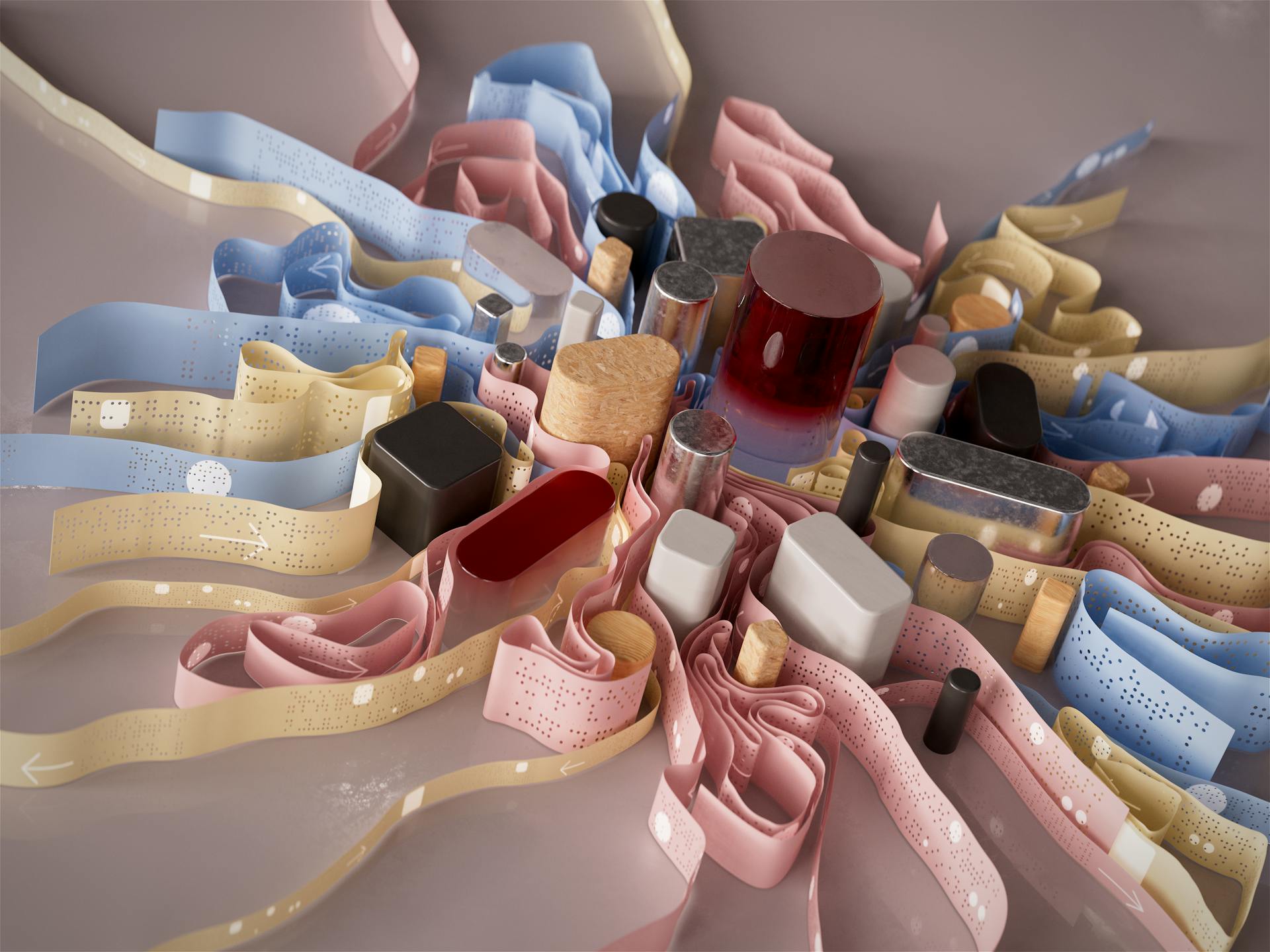
Scaled dot product attention is a fundamental component of transformers, a type of neural network architecture. It's a mechanism that allows the model to focus on different parts of the input sequence when generating the output.
The scaled dot product attention mechanism is based on the dot product of two vectors, which is a simple yet powerful operation. This operation is scaled by a square root of the dimensionality of the vectors, which helps to prevent the growth of the dot product.
This scaling is crucial for the attention mechanism to work properly, as it prevents the dot product from becoming too large and dominating the output. The square root of the dimensionality of the vectors is used for this purpose, which is a well-established technique in the field of machine learning.
Transformer Basics
The Transformer architecture is a game-changer in the world of natural language processing (NLP). It's based on two big ideas: attention-weighting and the feed-forward layer (FFN). Both of these ideas combined allow the Transformer to analyze the input sequence from two directions.
The attention mechanism is a technique used in Deep Learning applications that processes an input data and focuses on the more relevant input features based on the context. It was first used in NLP to improve the performance of Machine Translation tasks, and it's inspired by human cognitive attention.
The Transformer's attention mechanism is powered by the scaled dot-product Attention, which consists of the QK-module and outputs the attention weighted features. This is an efficient way to calculate the relevance between a query and a set of key-value pairs.
There are mainly two types of calculating Attention: Additive Attention and Multiplicative Attention. Multiplicative Attention is comparatively more efficient than Additive, but both of them are fairly similar when 'd' is small. However, when the dimension d is large, Dot-Product attention performs poorly when compared to Additive Attention.
The scaled dot-product Attention uses three types of vectors: Q-Query Vector, K-Key Vector, and V-Value Vector. The size of both the Query and the Key vector should always be the same, but the size of the Value Vector can be different.
Scaled Dot Product Attention
The scaled dot product attention mechanism is a game-changer in the world of natural language processing. It's a critical component of the self-attention mechanism, which allows the model to learn which parts of the input are most relevant to the current task.
The scaled dot product attention formula is quite complex, but it can be broken down into simpler steps. We first compute the attention score with every other token by taking the dot-product of their query and key vectors, which gives us a measure of how much focus one token should have on another.
To avoid large dot-product values, we scale the dot-products by dividing by the square root of the dimension of the key vectors. This scaling is important to ensure model training stability and prevent vanishing or exploding gradients.
The scaled dot product attention mechanism has a mean of zero but a variance equal to the number of dimensions, which is a problem we want to avoid. We prefer these values to have a variance equal to one, which is why we need a scaling factor.
In the case of self-attention, attention masking is optional, but it's a technique to control the parts of the input sequence that a particular position can attend to. This is particularly important in next-token prediction tasks, like in LLMs.
Input sequences with varying lengths require a technique called padding, where a padding token is added to facilitate batch processing during model training. However, we want the model to prevent attending to padding tokens because they don't contain helpful information.
The scaled dot product attention mechanism is a powerful tool that can be used in various applications, including natural language processing and machine learning. It's a critical component of many state-of-the-art models, including transformers and bidirectional transformers.
Matrix Multiplication
Matrix Multiplication is a crucial step in scaled dot product attention.
The first matrix multiplication computes the similarity between the Query Matrix and the Key Matrix by performing a dot product operation.
To perform a dot product, the column value of the first vector should be equal to the row value of the second vector, so the Key Vector is transposed.
Take a look at this: Pytorch Scaled Dot Product Attention
After the multiplication, the compatibility matrix is obtained.
The attention weight matrix A is obtained by feeding the input features into the Query-Key (QK) module, which tries to find the most relevant parts in the input sequence.
Self-Attention comes into play while creating the Attention weight matrix A using the QK-module.
Matrix multiplication is used again in the last step of scaled dot product attention, where the Attention Matrix A is multiplied with the Value Matrix.
After this multiplication, the final matrix of dimensionality Txd is obtained, which is the final output of the Attention Layer.
Weight Calculation
The attention score for each token is computed by taking the dot-product of its query and key vectors. This gives us a measure of how much focus one token should have on another.
To avoid large dot-product values, we scale them by dividing by the square root of the dimension of the key vectors. This ensures model training stability and prevents computational issues.
The softmax function is used to convert the attention scores into weights that sum to one. This is done by normalizing the scores across all keys for a given query.
The softmax function makes the largest scores stand out more, so if one score is much higher than the others, its corresponding probability will be much closer to one, while the others will be closer to zero.
The output of scaled dot product attention is a weighted sum of the values, where the weights are determined by the similarity between the query and each key.
Implementation Details
Scaled dot product attention is a type of attention mechanism that's widely used in transformer models. It's based on the idea of computing the dot product of two vectors.
The scaled dot product attention mechanism uses three main components: query, key, and value vectors. The query vector is used to compute the attention weights, while the key and value vectors are used to compute the output.
The query vector is computed as the product of the input sequence and a learned weight matrix. This is done to get the query vector that will be used to compute the attention weights.
Fused Implementations
When we're talking about fused implementations, it's essential to know that they're optimized for specific input types.
For CUDA tensor inputs, the function will dispatch into one of the following implementations: FlashAttention, Memory-Efficient Attention, or a PyTorch implementation defined in C++.
These implementations are designed to provide fast and memory-efficient attention, which is crucial for large-scale models.
FlashAttention, in particular, is known for its IO-awareness, which helps to minimize memory usage and improve performance.
Here's a brief overview of the fused implementations:
Hardware Dependence
Your results might be different depending on the machine you ran the code on and the hardware available.
If you don't have a GPU and are running on CPU, the context manager will have no effect and all three runs should return similar timings.
Depending on the compute capability your graphics card supports, flash attention or memory efficient might have failed.
Self-Attention
Self-Attention is a crucial part of the transformer architecture, specifically in the inner shell. It's a combination of the Query-Key module and the SoftMax function.
The Query-Key module plays a key role in this technique, but we won't dive into its details here. The SoftMax function is used in Self-Attention, but its role is also not fully explained in this article section.
Self-Attention can be visualized using the spotlight analogy, where the model throws light on each element of the sequence and tries to find the most relevant parts.
Self-Attention
Self-Attention is a crucial component of the transformer architecture, and it's often referred to as the inner shell. The self-attention mechanism is part of the attention-weighting feature.
The self-attention mechanism is based on the Query-Key module and the SoftMax function. This technique is discussed in detail by Prof. Tom Yeh in his AI by Hand Series on Self-Attention.
To understand Self-Attention, imagine a spotlight analogy where the model throws light on each element of the sequence and tries to find the most relevant parts. This analogy helps visualize the model's process.
The self-attention mechanism is the 'scaled' part of the scaled dot-product attention. This is a key concept to grasp when working with Self-Attention.
Here's a breakdown of the self-attention mechanism:
- The Query-Key module plays a crucial role in this technique.
- The SoftMax function is also an essential component of Self-Attention.
Self-Attention is often used in conjunction with the outer shell, which includes the attention-weighting mechanism and the feed forward layer. This combination is what makes the transformer architecture so powerful.
Conclusion
We've covered a lot of ground in this tutorial, and now it's time to wrap things up.
In this tutorial, we've demonstrated the basic usage of torch.nn.functional.scaled_dot_product_attention.
The sdp_kernel context manager is a useful tool that can be used to assert a certain implementation is used on GPU. This can be a big help when working with complex models.
We've also built a simple CausalSelfAttention module that works with NestedTensor and is torch compilable. This module is a great example of how to apply self-attention in a real-world setting.
By using the profiling tools, we can explore the performance characteristics of a user-defined module. This is a crucial step in optimizing our models for better performance.
Sources
- https://iq.opengenus.org/scaled-dot-product-attention/
- https://medium.com/@funcry/in-depth-understanding-of-attention-mechanism-part-ii-scaled-dot-product-attention-and-its-7743804e610e
- https://pub.aimind.so/scaled-dot-product-self-attention-mechanism-in-transformers-870855d65475
- https://www.i32n.com/docs/pytorch/tutorials/intermediate/scaled_dot_product_attention_tutorial.html
- https://towardsdatascience.com/deep-dive-into-self-attention-by-hand-%EF%B8%8E-f02876e49857
Featured Images: pexels.com


